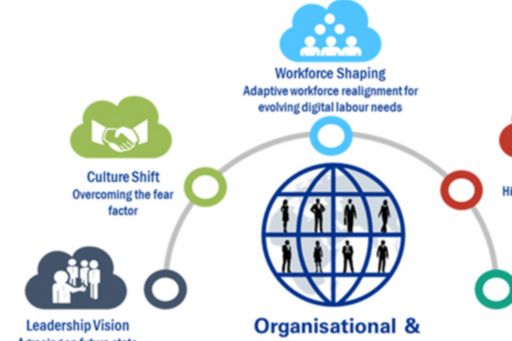The Human Implications of Digital Labour
The Human Implications of Digital Labour
This article was first published in the Feb / March 2017 issue of Access Asia Magazine.
As governments and businesses seek to maximise opportunity, advanced technologies play an important role. The rise of digital labour can be attributed to the historical shift from the Industrial Revolution to the Information Age, where industries are being reinvented with the rise of a new digital-based economy. Klaus Schwab, founder of the World Economic Forum, refers to the new ways that humans and machines connect and relate, as the 4th industrial revolution1 . Still in its early stages, Industry 4.0 involves the combination of human-machine intelligence with modern technologies, most of which are getting faster and less expensive to deliver.
While organisations are exploring the benefits associated with advancing technologies, this convergence is resulting in a blurring of lines between the physical and the digital, with the ability to create major disruptions to ‘work’ as we know it. Traditionally, change was driven by transforming people, process or technology. But as Mark Goodburn, Global Head of Advisory, KPMG International points out, “in a digital world, the interplay between these three dimensions is more dynamic – and the pace of change considerably more accelerated. Those who embrace change and adapt quickly will be rewarded.”
While many have been fast to embrace the benefits of technological change in their social and personal lives, there is often resistance when this change impacts jobs. Kegan and Lahey describe this “immunity” to change as a paradoxical short-term self-defence mechanism and is a fundamental hindrance to organisational transformation2 .
The challenge for leaders is to learn how to integrate this change and make the most out of both human and digital labour. To do this successfully, organisations should be proactively reflecting on these five considerations (as seen in the diagram):
- Leadership Vision: Digital labour will demand changes in operating models, infrastructure and management. Organisational direction must be assessed against the transformative power of digital labour. Leaders must have clear alignment around the timing, readiness and scope of the digital labour effort in order to leverage a future-proofed vision.
- Culture Shift: Combining Human and Digital labour has implications which are expected to bring an exponential amount of change to the culture of an organisation. Core values, personalities and unwritten rules need to be revisited and adapted to reflect a new reality. Building in agility and resiliency will be key to overcoming potential misconceptions and resistance.
- Workforce Shaping: Current efforts to reshape a ‘Digital organisation’ too often centre on redesigning job roles rather than redesigning the actual work. Human-centred organisational design is needed to help reshape workforces, since some technologies will augment, reduce, or even replace human labour. This presents an opportunity to truly change the way ‘work’ works.
- Talent Management: Reshaped workforces bring new talent challenges. Clarity of future talent needs, identification methods and reskilling efforts need to be invested in to move forward and prevent the loss of organisational knowledge. Proactive talent management should extend an organisation’s focus beyond the traditional full-time employment labour market, be scenario-based, and agile to manage future needs.
- Changing Behaviours: Behaviour change is always challenging, especially so when it involves navigating complex relationships between humans and digital labour. A carefully developed and implemented change management strategy, learning and development programme, and change readiness plan will be essential.

As history proves, inventions have always created more higher-value jobs, just think about the plough and automobiles. According to futurist Ross Dawson, it will be key capabilities such as collaboration, problem solving, decision-making, framing decisions, sense-making, synthesis, trust building, and influencing which will be deemed irreplaceable and where human labour should be centred. To truly achieve the productivity gains offered by advancing technologies, Dawson believes that recognition of distinctive human capabilities is central to the design of education, organisations and the definition of work.3
It is without a doubt that many jobs will morph and modify over time, with many workers having to learn new skills. Some countries like Singapore are actively endorsing and funding initiatives such as SkillsFuture to help impacted workers achieve this with minimal financial outlay. It is certainly an exciting time which requires opportunism, innovation and critical thinking. If we can each get past our immunity to change, we as humans and workers can more readily accept that change associated with Digital Labour does not destroy opportunity, rather it simply relocates it.
Carolyn Chin-Parry and Peta Latimer, who are respectively Director and Partner, People & Change, Management Consulting, KPMG in Singapore. The views and opinions are those of the authors and do not necessarily represent the views of KPMG in Singapore.
1 Klaus Schwab, The Fourth Industrial Revolution, World Economic Forum, 2016.
2 R Kegan and L L Lahey, Immunity to Change, Harvard Business School Press, February 2009.
3 R Dawson, http://rossdawson.com/blog/framework-the-role-of-humans-in-the-future-of-work/